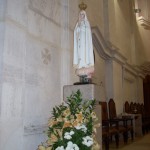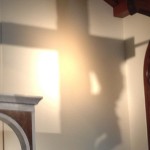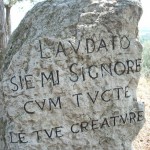If Candlemas day be dry and fair
The half of winter’s to come, and mair
If Candlemas day be wet and foul
The half of winter’s gane at Yule
If the Scots rhyme and the Punxsutawney woodchuck are correct, southern Ohio’s in for it. We’re dry and fair and sunny today on this last day of the Renaissance Christmas season (attention, people of Ohio, this means you can finally take your Christmas decorations down!), so it’s harder to appreciate the significance of light on this feast day than it would be if we were locked in our usual bleak midwinter.
February 2 has been known by many names through the centuries in the Churches of the West and of the East–the Presentation of the Lord, the Purification of Mary, the Hypapante (Meeting), and Candlemas. The first three titles point to the scriptural account (Luke 2:22-40) at the heart of it, recalling the presentation of the 40-day-old Child Jesus at the Temple by Mary and Joseph and Mary’s ritual purification after giving birth. According to Jewish law, the first fruits of all creation belong to God; to reclaim their first-born son, the family offered the substitute sacrifice (economy version) of two pigeons. Orthodox Jews today still practice this custom of pidyon haben, or redemption of the first-born son, by giving 5 silver coins to a Kohen, a member of the priestly lineage of Aaron. For you relic lovers, the Catholic Encyclopedia asserts that 800 years of tradition stand behind the claim of the Dubrovnik Cathedral in Croatia to possess the swaddling clothes little Jesus wore that day. The golden reliquary in which they rest is worth more than many, many flocks of pigeons.
The title Purification of Mary comes from another requirement of Jewish law, that a woman be considered ritually unclean for 40 days after giving birth to a son. Once that time of separation from society is fulfilled, the woman is ritually purified by immersion in the mikvah, the ceremonial bath. (Catholics believe that neither Jesus, as the Son of God, nor Mary, as a virginal mother, was subject to these provisions of Jewish law, but that they fulfilled these out of devotion and solidarity with their fellow Jews.) It’s important to understand that the notion of ritual uncleanness has nothing to do with physical disgust or moral condemnation surrounding birth (or other natural processes like menstruation or preparing a corpse for burial, all of which make people “unclean” for a time); the laws are more about maintaining a strict separation, a kind of buffer zone, between the temporal and the sacred.
And it’s not only in Jewish law that this custom held. Well into our own time, Catholics and Anglicans celebrated the “churching” of a woman–her ceremonial return to the public life of faith 40 days after giving birth–with the lighting of candles and the praying of a special blessing. My own mother was not present at my baptism, which took place within a week of my birth, because she was not yet churched. As was the custom in our Boston Irish parish, it was my godmother who brought me to the font. In these days when mothers often have to return to work and very public life days or even hours after giving birth, 40 days at home seems like a luxury and a blessing indeed.
The “meeting” celebrated today is the Holy Family’s encounter at the Temple with the aged prophets Anna and Simeon. These two symbolize Israel’s long yearning for the Messiah, whom they recognize in the Child. Blind Anna sees into Mary’s heart, and tells her that a sword–of great joy and of great suffering–will pierce it. In art, the sword is incorporated into the emblem of Mary’s Immaculate Heart, which is also ringed with roses and crowned with fire. The sword-pierced heart is an especially evocative symbol for me, as it is the emblem of the Immaculate Heart sisters who taught me, the logo of the parish, elementary school, high school and college I attended in Hollywood, and the seal on the class ring I once wore (and that America’s Top Model Tyra Banks still proudly flaunts as daily bling). Every woman who loves, and especially every woman who becomes a mother, opens her heart to that sword.
Simeon’s song of praise in honor of the Messiah’s coming, the canticle known as the Nunc dimittis, is traditionally prayed at Compline, the last office of the day. The Grail translation is particularly lovely:
At last, all-powerful Master
you give leave to your servant
to go in peace, according to your promise.
For my eyes have seen your salvation
which you have prepared for all nations,
the light to enlighten the Gentiles
and give glory to your Israel, your people.
The theme of Jesus as Light gives this feast its final name, Candlemas. The fourth-century pilgrim nun Egeria, who kept the first Christian travel diary, tells of this feast being kept in Jerusalem with a candlelight procession. From at least the Middle Ages, it became the custom to bless and distribute beeswax candles on this day–some to be used in tomorrow’s Blessing of Throats on the Feast of St Blaise. (This is just a great run of days for a Catholic trivia blogger like me!) In Poland, the blessed candles are known as gromnicy, or “Mary’s thunder candles,” and are believed to protect against dangerous spring storms.
So we’re back to spring, and weather predictions, in a big circle of celebration and lore. Whatever the weather, let us rejoice in the light and carry it to others however we may, as we are enjoined to do by St Sophronius in the sermon read at today’s Office of Readings:
The true light has come, the light that enlightens every man who is born into this world. Let all of us, my brethren, be enlightened and made radiant by this light. Let all of us share in its splendor, and be so filled with it that no one remains in darkness. Let us be shining ourselves as we go together to meet and to receive with the aged Simeon the light whose brilliance is eternal. Rejoicing with Simeon, let us sing a hymn of thanksgiving to God . . .
If your voice, like mine, is a little rusty, here are the Tallis Scholars singing Palestrina’s setting of the Nunc dimittis to thank God for this day.
Updated with other juicy links about this day:
- The Anchoress reposts a reflection on this, the feast day of her heart.
- At The Deacon’s Bench, Greg Kandra describes a parish celebration.
- Te Deum Laudamus provides the full text the reading from St Sophronius.











